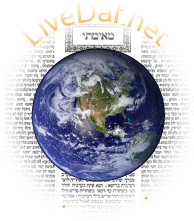When Shmuel allowed the patches to be planted side by side, the Gemara asked “But the leaves intermingle!”. Why doesn’t the Gemara simply ask from the fact that the two parallel rows are only separated by two tefachim – which is inadequate?
Rav Yochanan allows the (filled) round patches to be planted side by side, apparently by employing the concept of ‘Rosh Tur’ – since each patch is independently regarded. But the Gemara concludes that we will only apply ‘Rosh Tur’ to a patch shaped as a square – how is this compatible?

Tosafos explains that Shmuel holds that we do say Rosh Tur by an Aruga. Therefore, we are only asking that the leaves mingle, which is a problem even by a Rosh Tur, as Tosafos explains. Interesting though, is that Rashi here says that the leaves mix because they are only two Tefachim apart.
To answer both questions, we find that the first Rashi after the Mishna describes the function of the three Tefachim of Yenika, as a proper Heker. The Yenika itself was never an issue.
Another point to keep in mind is that although we are using the term Rosh Tur over here, this is not the original meaning. Rosh Tur is when a row penetrates another area, and we say that it is obvious to whom it belongs and doesn’t mix. Here we are discussing two Arugos side by side and we are saying that they should remain in their place clearly enough. We asked that we should apply the concept of Rosh Tur to the Aruga to allow them to be close to one another.
The whole concept of an Aruga, that according to Rashi is allowed to contain different plants very close to one another, is because it is a clearly defined area. This is even according to Rav. (Let’s not forget that Rashi’s explanation in the Mishna, which is not referred to in the Gemara, is actually Rav — once it is the only patch in the field.) Rav also agrees that although we may not plant a whole field of plants three Tefachim away from each other (according to Tosafos), we do this in an Aruga, because it is a clearly defined area.
The same applies to Rebbe Yochanan. Although he holds that a row penetrating is not clear enough, the Aruga itself is defined enough. It is possible to say that although we don’t say Rosh Tur to an Aruga this is only when a row goes from one into the other — like the common case of Rosh Tur in a field — we still do apply the concept to differentiate one Aruga from the next.
Rav holds that we don’t apply the concept learned from Rosh Tur to the Aruga when it is within three Tefachim of the next. Shmuel may argue and hold like Rebbe Yochanan. We asked how he can argue if the leaves mix; even the original Rosh Tur wouldn’t help. But, had they been three Tefachim apart we wouldn’t ask about the leaves.